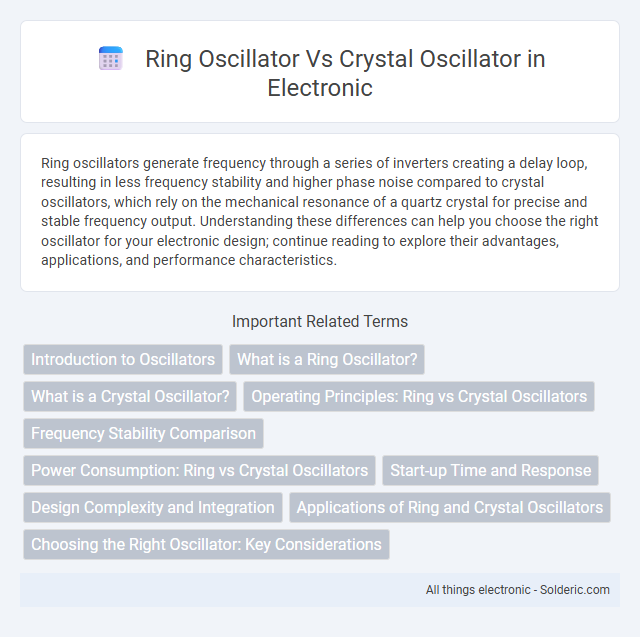Ring oscillators generate frequency through a series of inverters creating a delay loop, resulting in less frequency stability and higher phase noise compared to crystal oscillators, which rely on the mechanical resonance of a quartz crystal for precise and stable frequency output. Understanding these differences can help you choose the right oscillator for your electronic design; continue reading to explore their advantages, applications, and performance characteristics.
Comparison Table
| Feature | Ring Oscillator | Crystal Oscillator |
|---|---|---|
| Frequency Stability | Low | Very High |
| Frequency Range | Wide (MHz to GHz) | Narrow (kHz to MHz) |
| Size | Compact, On-chip integration | Larger, requires quartz crystal |
| Power Consumption | Low to Moderate | Low |
| Accuracy | Low | High |
| Temperature Sensitivity | High | Low |
| Cost | Low | Higher |
| Applications | On-chip timing, delay elements, testing | Precision timing, clocks, communication systems |
Introduction to Oscillators
Ring oscillators use a series of inverters connected in a loop to generate a periodic signal with frequency determined by the number of stages and propagation delay, making them ideal for integrated circuit testing and on-chip clock generation. Crystal oscillators rely on the mechanical resonance of a quartz crystal to produce highly stable and precise frequencies, widely used in communication systems and timing applications. The primary difference lies in stability and accuracy, with crystal oscillators offering superior frequency stability compared to the variable frequency characteristics of ring oscillators.
What is a Ring Oscillator?
A ring oscillator is a type of electronic oscillator composed of an odd number of inverters connected in a feedback loop, producing a periodic oscillating signal. It is commonly used in integrated circuits for testing process variations and generating clock signals due to its simple design and tunable frequency. Unlike crystal oscillators that rely on quartz crystals for frequency stability, ring oscillators offer flexibility in frequency adjustment but exhibit higher phase noise and less accuracy.
What is a Crystal Oscillator?
A crystal oscillator is an electronic oscillator circuit that uses the mechanical resonance of a vibrating quartz crystal to create an accurate frequency signal. It provides highly stable and precise frequency output, commonly used in clocks, radios, and microprocessors for timing purposes. Unlike ring oscillators that rely on inverter delay stages, crystal oscillators achieve superior frequency stability due to the quartz crystal's consistent oscillation characteristics.
Operating Principles: Ring vs Crystal Oscillators
Ring oscillators generate oscillations using a series of inverters connected in a loop, where the signal continuously propagates through the stages creating a waveform with a frequency determined by the number of stages and the propagation delay of each inverter. Crystal oscillators rely on the piezoelectric effect of a quartz crystal to produce highly stable and precise frequency signals by mechanically vibrating at its resonant frequency. Your choice between ring and crystal oscillators depends on the required frequency stability, accuracy, and application complexity.
Frequency Stability Comparison
Ring oscillators exhibit lower frequency stability due to their sensitivity to temperature, supply voltage variations, and process fluctuations, causing significant frequency drift over time. Crystal oscillators provide superior frequency stability by leveraging the piezoelectric properties of quartz crystals, maintaining precise oscillation frequencies with minimal deviation under varying environmental conditions. Your selection between these oscillators depends on the required stability level, with crystal oscillators preferred for applications demanding high-precision timing.
Power Consumption: Ring vs Crystal Oscillators
Ring oscillators generally consume higher power compared to crystal oscillators due to their continuous switching of inverter stages and lack of frequency stabilization. Crystal oscillators leverage a quartz crystal resonator that provides highly stable frequency output with minimal power consumption, making them ideal for low-power applications. Power efficiency in crystal oscillators typically surpasses that of ring oscillators, especially in precision timing circuits and battery-powered devices.
Start-up Time and Response
Ring oscillators exhibit significantly faster start-up times, often in the nanosecond range, due to their simplicity and fewer components, enabling rapid frequency generation. Crystal oscillators have longer start-up times, typically milliseconds to seconds, as the quartz crystal requires time to stabilize its resonant frequency. Response stability in crystal oscillators is superior, maintaining precise frequency under temperature variations, while ring oscillators often show frequency drift due to environmental changes.
Design Complexity and Integration
Ring oscillators offer simpler design complexity with fewer components and easier integration into CMOS processes, making them ideal for on-chip timing applications. Crystal oscillators require more complex circuitry and external quartz components, posing challenges for full integration but providing superior frequency stability. Your choice depends on balancing integration ease with precision requirements in your application.
Applications of Ring and Crystal Oscillators
Ring oscillators are widely used in integrated circuits for frequency synthesis, clock generation, and process variation monitoring due to their simple design and tunability. Crystal oscillators are preferred in applications requiring high frequency stability and precision timing, such as real-time clocks, communication systems, and GPS devices. The choice between ring and crystal oscillators depends on the specific requirements of frequency accuracy, power consumption, and integration complexity in electronic systems.
Choosing the Right Oscillator: Key Considerations
Selecting the right oscillator depends on factors such as frequency stability, power consumption, and application requirements. Crystal oscillators offer superior frequency accuracy and low phase noise, ideal for precision timing in communication and measurement systems. Ring oscillators provide compact size and ease of integration, making them suitable for on-chip clock generation in low-power digital circuits where absolute frequency stability is less critical.
ring oscillator vs crystal oscillator Infographic

 solderic.com
solderic.com